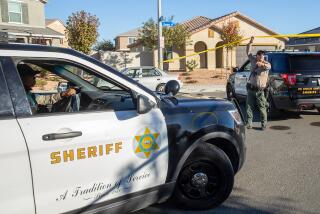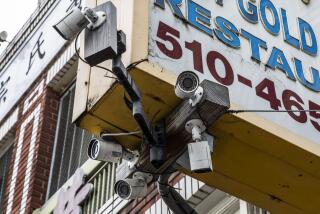Lancaster needs to act cautiously with aerial surveillance
We want sophisticated technology to protect us. But we don’t want it to stalk us. A new aerial surveillance system that the city of Lancaster put into place last week to reduce crime has the potential to do both, although with some strict monitoring, it might accomplish the former without subjecting residents to the latter.
Officials in the high-desert city unveiled a program in which a small plane, manned by a pilot and equipped with cameras capturing real-time video footage of the landscape below, will fly in a loop at 3,000 feet. The plane will fly for about two hours at a time, for up to 10 unspecified hours a day (so criminals can’t plan).
Mayor R. Rex Parris hopes the system will both deter criminals and catch the undeterred ones in the act; he says that if the city gets a call about a break-in, the cameras can be focused on the scene in seconds. The system will also help first responders — law enforcement officers, firefighters, paramedics, rescue personnel — get to the scene of a crime or accident faster and better informed about the situation than if they were sent out by a dispatcher who had no visual image.
The video feed will be monitored by one of three trained deputies on the ground — not that there’s much to see in the raw footage, officials say. Faces can’t be recognized; license plates cannot be discerned. Only when one of the deputies, guiding the cameras remotely, zooms in on a specific area will there be more detail. The deputy should be manipulating the cameras mostly in response to emergency calls.
Sounds like it could help crime fighters. But let’s face it, there’s something creepy about cameras hovering overhead just waiting to be zoomed in on some purportedly suspicious activity. Even Parris acknowledges the possibility for misuse. A voyeur at the camera controls could check out clothing-optional pool parties. More troubling would be law enforcement tracking people for non-emergency reasons. According to the mayor, every time the cameras are focused, a record will be made, and those records will be audited. Deputies will be held accountable for where they train the lenses.
Los Angeles County Sheriff’s Department officials in Lancaster say that when the cameras are not being trained on an unfolding crime, accident or other emergency, they may be deployed to view “problem areas” of the city. That’s of concern. Where might those areas be? And who will make those decisions?
These days, society often has to balance the value of sophisticated new crime-fighting technologies against the privacy rights of citizens. Parris says he’s open to making changes in the aerial system and to consulting with the American Civil Liberties Union. One place to start: the two-year period that the city intends to keep the video footage. That much data on people not suspected of a crime is unnecessarily invasive. Except for footage involving ongoing criminal allegations or an accident investigation, the city should dispose of the footage after a month or two.
More to Read
A cure for the common opinion
Get thought-provoking perspectives with our weekly newsletter.
You may occasionally receive promotional content from the Los Angeles Times.






